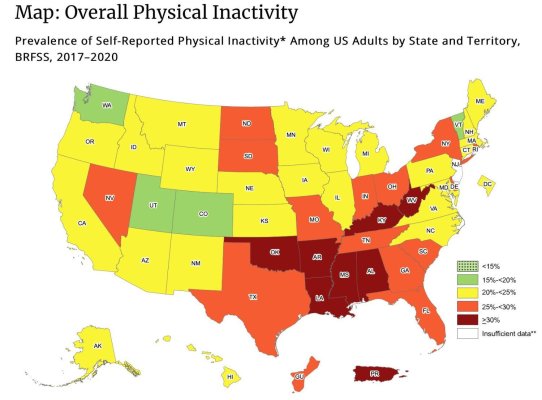We often have posts from things like Nerd Wallet suggesting where to live. We discuss our own desires as it relates to being close to friends and family, among many other important considerations.
We rarely (maybe never) discuss the activity level of state residents. The activity level speaks to the natural and constructed facilities available for our health and enjoyment. A consideration that perhaps not reviewed often.
Weather is important but as you will see, weather does not necessarily result in an active lifestyle given the sunbelt has among the lowest scores.
This post shares some of that data from the CDC study.
"More than 1 in 5 adults is inactive in all but four states, according to new state maps of adult physical inactivity prevalence released by the Centers for Disease Control and Prevention (CDC). For these maps, physical inactivity for adults is defined as not participating in any physical activities outside of work over the last month – activities such as running, walking for exercise, or gardening."
Here is the link to the CDC press release if you want to learn more:
https://www.cdc.gov/media/releases/...tent&eId=5208adf8-9c1e-4309-9873-10f8303f907e
We rarely (maybe never) discuss the activity level of state residents. The activity level speaks to the natural and constructed facilities available for our health and enjoyment. A consideration that perhaps not reviewed often.
Weather is important but as you will see, weather does not necessarily result in an active lifestyle given the sunbelt has among the lowest scores.
This post shares some of that data from the CDC study.
"More than 1 in 5 adults is inactive in all but four states, according to new state maps of adult physical inactivity prevalence released by the Centers for Disease Control and Prevention (CDC). For these maps, physical inactivity for adults is defined as not participating in any physical activities outside of work over the last month – activities such as running, walking for exercise, or gardening."
Here is the link to the CDC press release if you want to learn more:
https://www.cdc.gov/media/releases/...tent&eId=5208adf8-9c1e-4309-9873-10f8303f907e


